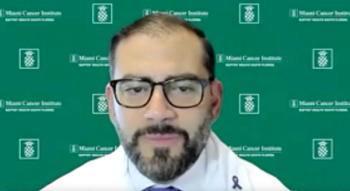
Uterine transposition is a newer tactic in the surgical oncology field to help preserve fertility for patients undergoing pelvic radiation.

Your AI-Trained Oncology Knowledge Connection!


Uterine transposition is a newer tactic in the surgical oncology field to help preserve fertility for patients undergoing pelvic radiation.
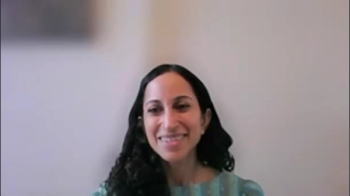
Samantha Shenoy, NP, MSN, emphasized educating patients with multiple myeloma to help prepare them for potential taste alterations after talquetamab.

Samantha Shenoy, NP, MSN, indicated that neurological issues were not prevalent with talquetamab, despite occurrences with other bispecifics antibodies.

Panelists discuss how GPRC5D bispecific therapies have shown promising efficacy in real-world relapsed/refractory multiple myeloma patients.

Panelists discuss how their clinical experience with GPRC5D bispecific therapies has been limited or nonexistent due to the novelty of these treatments in multiple myeloma.

Mary Steinbach, APRN, shares her experience in managing dysgeusia and nail- and skin-related toxicities seen in patients with multiple myeloma who receive talquetamab.

Focusing on patients with multiple myeloma who receive GPRC5D-targeted therapy, Beth Faiman, CNP, PhD, discusses how long-term treatment impacts patients’ tolerance to adverse events.
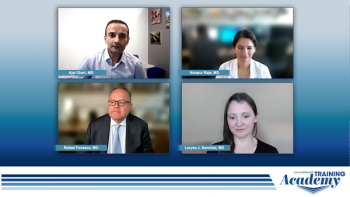
Rafael Fonseca, MD, discusses the role of bispecifics in relapsed/refractory multiple myeloma and the implications of incorporating them into combination regimens.

Noopur Raje, MD, reviews clinical research on elranatamab combination therapy in patients with relapsed/refractory multiple myeloma.
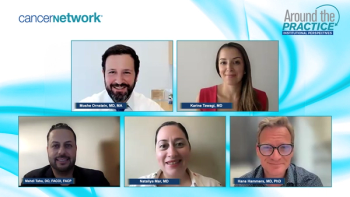
Medical experts examine how overall survival data from KEYNOTE-564 has influenced the use of pembrolizumab as adjuvant therapy.

Medical experts discuss significant adverse effects of TKIs and IOs, including management and patient education, and highlight exciting pipeline therapies for non–clear cell RCC, such as Ipi + Nivo and zanzalintinib + Nivo.
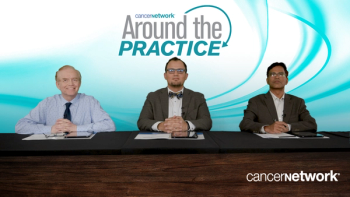
The discussion examines whether the CAR T-cell referral process differs for in-state vs out-of-state patients, the role of social factors, and any changes or challenges in the referral process following recent CAR T approvals.

Medical experts discuss the CAR T-cell therapy referral process between community and academic centers, how academic centers can aid community oncologists in identifying eligible patients, determining suitable referrals, and managing patient expectations.
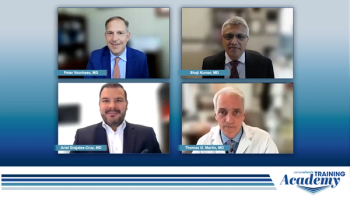
Focusing on treatment paradigms for patients with relapsed/refractory multiple myeloma, the expert panel discusses the role of BCMA-targeted bispecifics and how they might consider sequencing therapies.

Samantha Shenoy, NP, MSN, discussed common oral and dermatologic adverse effects associated with talquetamab in patients with myeloma.
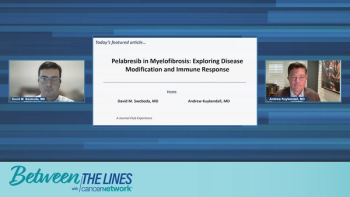
Panelists discuss approved and emerging therapies for myelofibrosis, focusing on how these treatments aim to modify the disease and improve patient outcomes.

Panelists discuss the MANIFEST-2 trial of pelabresib in myelofibrosis, focusing on its mechanism of action (MOA), study design, and impact on spleen volume reduction.

As the uterus is moved to the anterior abdominal wall, patients now have a chance of preserving their fertility during radiation therapy.

Combination therapy with JAK inhibitors may help improve efficacy outcomes for patients with multiple myeloma.

James R. Berenson, MD, discussed adverse effects associated with oral ruxolitinib plus selinexor in patients with multiple myeloma.
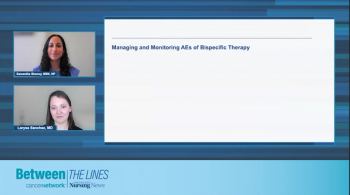
Experts provide advice for patients and caregivers with relapsed/refractory multiple myeloma considering talquetamab or another bispecific, while all faculty will discuss unmet needs and future perspectives in the treatment of relapsed/refractory multiple myeloma.

Experts discuss prophylactic measures for managing potential adverse events associated with talquetamab and other bispecifics, while all faculty will offer advice for health care providers involved in the care of patients receiving talquetamab.

The act of asking for help is critical to finding mentors who can help one advance in the brain cancer field, according to Yoshie Umemura, MD.
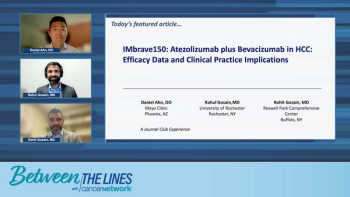
Key opinion leaders summarize essential takeaways and highlight unmet needs in the hepatocellular carcinoma treatment landscape.

The panel reviews the CheckMate 9DW study design and evaluates its safety data.
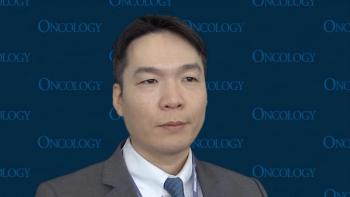
Patients with HR-positive, HER2-positive breast cancer and high-risk features may derive benefit from ovarian function suppression plus endocrine therapy.

Through multidisciplinary collaboration, Yoshie Umemura, MD, and colleagues were able to organize the Gliofocus trial in brain cancer relatively fast.

Following the presentation of a case of a patient with multiple myeloma, the panel have a roundtable discussion on how to approach treatment.

A panel of myeloma specialists review the case of a 67-year-old patient with multiple myeloma (MM) who received a bispecific antibody.

Experts on multiple myeloma offer clinical insights on preparing patients who are going to receive GPRC5D therapy, highlighting step-up and treatment dosing for talquetamab.